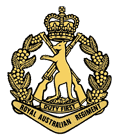Pte Lindsay Noel Brown
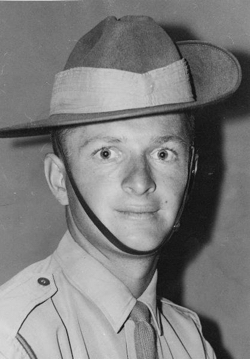
3790530 BROWN Lindsay Noel, 22, of Bendigo, Victoria, was an apprentice fitter and turner when called up in February 1967. The rifleman private with 3RAR was killed in an enemy attack on Fire Support Base Coral, Bien Hoa, in the early hours of May 26, 1968. The defence of Fire base Coral and Battalion defence position Balmoral was the largest Australian action of the Vietnam war.
Balmoral was assaulted by a North Vietnamese battalion force initiated by an intense barrage of small arms, machine gun, mortar and RPG rocket fire. Pte Brown (10 Platoon D Company and Pte Desnoy (12 Platoon D Company) died as a result of this barrage.
Pte Cooper and Pte Thomas
of A Company were also killed in the same action . The barrage was immediately followed by ground assault.
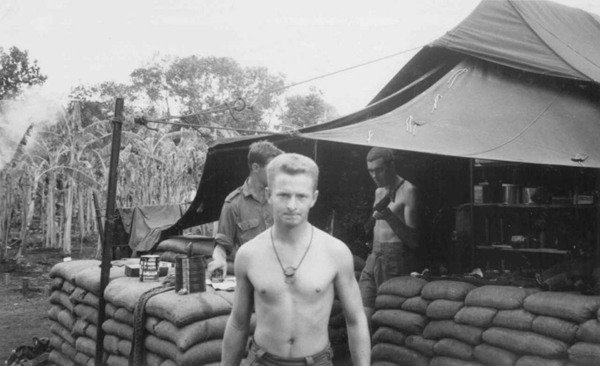
This tribute
is a combination of 2 memorials written by Premier’s Anzac Spirit School Prize delivered by Kelly Parkin on Thursday, October 4th, 2018 and the
Australian War Memorial
Last Post Ceremony Story delivered 26 May 2018
Today we remember and pay tribute to Private Lindsay Noel Brown.
Lindsay Noel Brown was born on Christmas Day 25 December 1945 in Bendigo, Victoria, to Norman and Elizabeth Brown and was lost to the overwhelming impact of artillery fire in 1967. A significant death, that left his wife and family with heartache that could not be healed and left his comrades with immense pride and sorrow.
Through the tough experiences, unbreakable bonds were formed, and the mates of Lindsay’s were like none other. They were also his brothers. One of his mates took the photo that is shown above. His name is Graedon Dickson, and was a young Australian Private, like Lindsay. He expressed his gratitude of sharing his war service with the -“kind, down-to-earth, gentle” man that Lindsay was.
Graedon had also experienced the same horrific event, but had also endured the pain of returning to his country, that had been overwhelmed with disgraceful comments and dishonorable actions towards the surviving veterans. These men are just as important as those who passed within the foreign lands of Vietnam, as some also passed, or struggled, when they reached home due to the mental destruction that was inflicted, and strengthen, from the changed society, and reality.
He was a true Mallee boy, with a childhood that consisted of days attending the local primary school, and completing simple farming tasks. He grew up on his family’s farming property known as
“Glen-Alvie”, located at Upper Lurg near Benalla.
He had a close relationship with his twin brother, Rob, and younger sister, Ruth.
Lindsay possessed a friendly personality, that was often shown through his luminous coloured striped socks. Lindsay was a fun loving, but responsible man, and was regularly known to be cheerful, as he always greeted his mates with a common saying “how’d you be?”.
In Benalla he attended the local primary school before going on to Benalla Technical College. He left school after gaining his intermediate technical certificate in 1961 and the following year went to work for BV Reynold Chains as an apprentice fitter and turner.
As part of his apprenticeship, he returned to Benalla Technical College for the study component of his trade. He gained his qualification in 1964 and continued his apprenticeship until January 1967, when he qualified as a fitter and turner. Just before finishing his trade certificate, Brown met his future wife, Lorraine, and the pair began a relationship. He was an earnest young man and was keen to get married and settle down. He remained working with his employer and, being mechanically minded, enjoyed working on his own car, a cherished cherry red FJ Holden in his spare time.
The Australian government had introduced national service in 1964, and with the decision to commit ground troops to Vietnam in 1965, the Australian Army began expanding. Brown attended a pre-enlistment medical screening in late October 1966 and was passed fit.
On the 1st of February 1967 Brown was called up for two years’ National Service. His enlistment papers were stamped “potential officer” and he was noted as being “a polite, well dressed lad [and a] decent type”. Unfortunately, his twin brother was deemed unfit for service, which prominently affected him long term, after the news of his Lindsay’s death…
After basic training at the 2nd Recruit Training Battalion at Puckapunyal, he was posted to the School of Infantry at Singleton. Completing his infantry training in June, he was posted to the 3rd Battalion, The Royal Australian Regiment which was based at Woodside in South Australia, and joined D Company. As the battalion was readying for deployment to Vietnam, the training was intense.
During his last period of leave home to Benalla, on the 11th of November, Lindsay and Lorraine were married. He was 21 years old, Lorraine was 18.
Brown celebrated his 22nd birthday and Christmas before flying out of Adelaide for Vietnam in 1967. Landing at Vung Tau, Brown and the other members of 3RAR’s rear party joined the main battalion and were taken by trucks to Nui Dat.
3RAR conducted its first operation in early January 1968 and over the next four months was involved in operations including mine clearing and reconnaissance-in-force.
Brown returned to Australia and spent a week in Sydney on leave at the beginning of April 1968, but was soon back in Vietnam on field operations.
On 12 May, 3RAR, along with 1RAR, 102 Field Battery and other supporting units, was flown to a position 25 kilometers north of Bien Hoa, where they set up Fire Support Base Coral, tasked with disrupting enemy troops withdrawing from Saigon after a major offensive. FSB Coral was attacked the same night, and the Australians suffered nine killed and 28 wounded.
3 RAR left Coral and set up FSB Coogee nearby before being sent to establish a defensive position Balmoral on 24 May. Defences were still in the process of being completed when two North Vietnamese Army main force regiments launched an attack, attempting to overrun the base in the early hours of 26 May.
D Company took the brunt of the initial assault. During the fierce fighting Lindsay Brown was struck in the head by shrapnel and was killed instantly.
The soldiers of 3RAR and the Centurion tanks of 1 Armoured Regiment fired canister rounds and machine-guns, forcing the enemy to break and withdraw. Four men from 3RAR had been killed and a further 14 wounded. Two nights later 3RAR held off a second ground assault and suffered a further man killed and six wounded.
(The second attack as described by Kelly Parkin)
Unfortunately, the night came when Balmoral’s second attack occurred, which had suffered a similar battlefront as the Fire Support Base Coral attack. At 0345 hundred hours, Lindsay, and many more nervous men, witnessed a green flare vividly light up the solemn night sky. This marked the beginning of another battle. The sky that had once offered Lindsay soothing support, had now changed abruptly into the familiar artificial weather of enemy artillery fire in a matter of seconds. The intensity of artillery rainfall was drastically altered within this attack, but was of similar density of what was witnessed at FSB Coral. Inversely, the Vietnamese soldiers were closer than those on the attack at FSB Coral, and were attempting acts of bravery to enter through the wire opening-that was earlier used as a doorway for the Mk 5 Centurion tanks. Vietnamese men swarmed in from numerous hidden bunkers that were buried within the Earths soil, and continued to storm eagerly towards Lindsay, and his mates, wave after wave. An onslaught of mortars, rocket-propelled grenades, and machine guns, were used against the Australian troops, however, the blessed presence of the indestructible Centurions helped increase the impossibility of the enemies attempt to march through the barriers. As the attack went on, two Australian men were killed, and 14 men were wounded from 3RAR.
Private Brown was seen lifeless in his comrade’s arms; Private Ray McDonald, in an incomplete-pit that was made hastily the night before. Whilst struggling with a face wound, Private Ray McDonald, endured the pain from the blast that had potentially killed Lindsay. As this occurred, Private Barry Bryan, who was in the sentry duty pit, just eight metres away from his two comrades, eagerly crawled over the sturdy barriers, into the open grounds, as his instinct to save them had formed from his past war experiences. Whilst eagerly crawling towards the pit, Bryan was weakened with shrapnel wounds, but dismissing powered on. Once he finally managed to successfully reach the pit, he aided the screaming of his mate, Ray, and agreed to Lindsay’s deceasing. Bryon was the last man to hold Lindsay’s lifeless figure for the last time in his arms before the Huey’s came in and took him away.
End of Kelly’s description.
Lindsay Noel Brown’s remains were returned home and were laid to rest on the 11th of June 1968 in the Benalla Lawn and Memorial Cemetery. Lindsay's wife Lorraine had the following epitaph added to his headstone;

Dearly loved and ever missed
By your loving wife Lorraine
Lindsay Noel Brown was 22 years old.
His name is listed on the Roll of Honour on your right, along with more than 500 others from the Vietnam War.
We now remember Private Lindsay Noel Brown, who gave his life for us, for our freedoms, and in the hope of a better world.
Survived by Sister Ruth and twin brother Rob Brown.
Return to 3rd Battalion Roll of Honour Menu 1968
|
Pte John Alexander Campbell
2787278 CAMPBELL Private John Alexander 21 Years. (D Company), from Campsie in New South Wales, served with the 3rd Battalion, Royal Australian Regiment in Vietnam in 1967-68. He was called up in July 1967 and was killed in action a year later in Biên Hòa Province. He was aged 21 at the time.
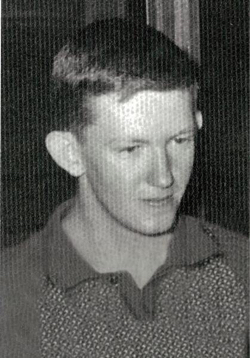
Private Campbell was one of three Australian soldiers killed in operation Platypus against the Viet Cong in August 1968. Six other troops were wounded when an Armoured personnel carrier struck a land mine. John was KIA by sniper fire on the morning of the 3rd August 196.
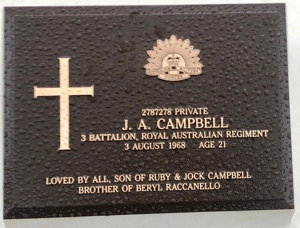
(Cemetery or memorial details: Rookwood Military Cemetery, Rookwood, Sydney, New South Wales, Australia)

Return to 3rd Battalion Roll of Honour Menu 1968
|
Sgt. Ronald Thomas Carroll
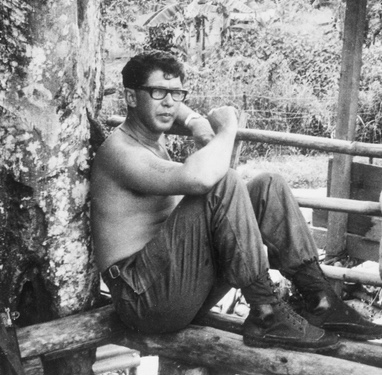
AWM Photograph Sgt R T Carroll in Borneo 1965..
14208 3RAR - Sergeant. Ronald Thomas. Carroll, 31 years. Moree NSW. Carroll was killed in action in Bien Hoa Province 4th August 1968. He was buried at Terendak, Malaysia
14208 CARROLL SGT Ronald Thomas- 31 year old Platoon Sergeant of 10 Platoon, D Company 3 RAR moved to the flank of a well concealed heavily defended enemy position when he was killed by an enemy sniper concealed in a tree. Two other D Company soldiers were WIA in this action.
KIA in South Vietnam by gunshot wounds on 4 August 1968.
Battalion defensive position Balmoral was assaulted by a North Vietnamese battalion force initiated by an intense barrage of small arms, machine gun, mortar and RPG rocket fire. Pte Brown (10 Platoon D Company and Pte Desnoy (12 Platoon D Company) died as a result of this barrage.
Pte Cooper and Pte Thomas
of A Company were also killed in the same action . The barrage was immediately followed by ground assault.
Esperance local bids final farewell to
WA Vietnam veteran
Esperance News -June, 2016
The body of West Australian soldier Ronald Carroll was brought home almost 50 years after he was killed serving his country in the Vietnam war. Sergeant Carroll was a member of the 3rd Battalion, Royal Australian Regiment (3RAR) and was killed in South Vietnam in August 1968. Sgt Carroll was among 25 fallen soldiers and eight family members who were brought back to Australia from cemeteries in Singapore and Malaysia where they were buried by the Federal Government.
Former Prime Minister Tony Abbott said the government would bring the soldiers bodies home to be repatriated in Australia if the families chose to do so. Sgt Carroll was buried at Karrakatta Military Cemetery with full military honours on Tuesday, June 7. Esperance local Richard Fowler was in the same company as Sgt Carroll and was there on the day he died. Mr Fowler flew to Perth for the ceremony which he said was very emotional for him.
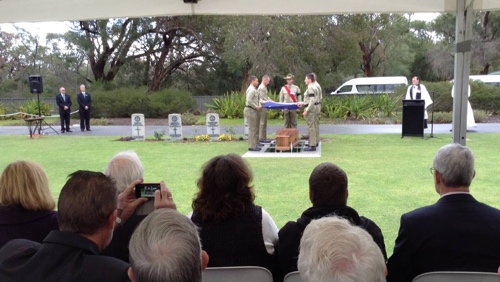
“The main speaker was the current commanding officer of the 3RAR, the carrying party were members of the same platoon Ron Carroll was in, in Vietnam,” Mr Fowler said. Mr Fowler said Sgt Carroll’s son Peter and daughter Jo were present. “To them it was closure,” Mr Fowler said. “His son was a baby [when Sgt Carroll died] and she was only three and only just remembered her Father.” Mr Fowler was the NS officer in command of the 10th platoon, 3RAR and Sgt Carroll was in command of the 12th platoon.
“He was in the forward platoon that was involved in the assault, and I was in the rear platoon that went in and helped extract him after he had been wounded,” Mr Fowler said. Mr Fowler said he and his platoon entered the site under heavy fire and put Sgt Carroll on a stretcher which was winced out of the jungle by a helicopter. “He died about 5 minutes after he left the contact site,” Mr Fowler said. “It was scary, we were involved in a heavy fire fight, and the enemy soldiers were dug in their bunkers and they were firing machine guns as we were trying to assault them.” “It was at least half an hour until we had him out of the battle site and onto the helicopter, so it was too long,” Mr Fowler said.
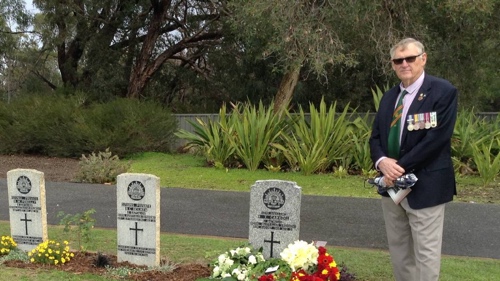
He said that attending the ceremony in Perth had brought him and members of 3RAR closure.

CONTACT VVAA (WA) Page 1, June 2016
Re-interment Service for Sergeant Ronald Thomas Carroll. 17 December 1936 – 4 August 1968. Ron Carroll’s military service began at 19 years of age, as a National Serviceman in 1955, before later transferring to the Regular Army. As a member of 3 RAR, Ron served in Singapore, Malaya, Borneo, Malaysia and South Vietnam. Ron Carroll, transferred to the SAS Regiment, following injuries sustained in a motor vehicle accident, during SAS training, he transferred back to 3 RAR.
During 3 RAR’s 1967-68 tour in South Vietnam, Sgt Carroll was killed while leading his platoon, in an assault on an enemy base camp, Operation Hamersley, in Bien Hoa Province, on the 4th August 1968. Current members of Townsville based 3 RAR, formed the bearer party for the coffin with Sgt Carroll’s body. Battalion CO, Lt-Col Giles Cornelia, told the service that the regiment was humbled to help bring one of their own home. Lt-Col Cornelia, read Sgt Carroll’s record of service. Former army mates, Curly Tremble, Bunbury and Neil Eiby, travelled from Queensland to attend the service. Both were in action the day their mate was killed. Padre Richard Whereat, read a message from Sgt Carroll’s daughter Joan and son Peter, in which they thanked the people of Malaysia for looking after their father for 48 years.
“We are sorry to disturb you Dad with this process but we trust you will believe it is for the better, so that for us that remain, we can finally say goodbye”.
Return to 3rd Battalion Roll of Honour Menu 1968
|
Pte Robert John Caston

4719003 CASTON Robert John, 21, of Adelaide, South Australia, was called up in April 1967 and went to Vietnam in December that year with D Company, 3RAR.
Private Caston died of wounds at the 24 US Evacuation Hospital at Long Binh on February 4, 1968 after being hit by a sniper’s bullet at Long Dien during the Tet offensive.

Dearly loved son of Clem and Ann, brother to Susan and Phillip. RIP
Return to 3rd Battalion Roll of Honour Menu 1968
|
Pte Kevin George Coles
55294 COLES Kevin George - 3 RAR
Born: Perth, Western Australia. 21, married, of Athol Park, South Australia,- KIA in South Vietnam on 22 March 1968
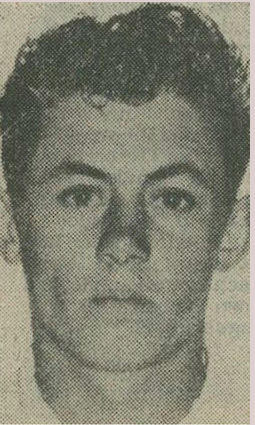
On 24 March 1968, 7 and 9 platoons was engaged in clearing a safe lane along a gully towards a suspected tunnel entrance. During this slow and deliberate phase, 2Lt. Fraser accidentally triggered a captured M16 anti-personnel mine which had been placed by the Viet Cong to protect the tunnel's mouth. The M16 was of American manufacture and designed to jump about 3 ft. (91 cm) into the air before exploding. When he heard the mine arming, Fraser deliberately used his body in an effort to smother the effects of the blast and minimize injuries to those members of his platoon who were close by.
The explosion fatally wounded him and seriously injured seven others over a period.
Return to 3rd Battalion Roll of Honour Menu 1968
|
Pte Alan John Cooper
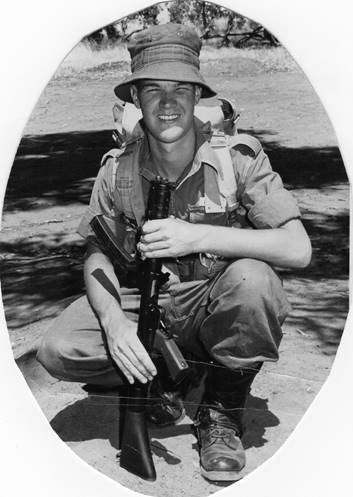
4411171 COOPER Alan John - 3 RAR. 20 Years
Born: - Rose Park, South Australia - KIA in South Vietnam on 26 May 1968.

Battalion defensive position Balmoral was assaulted by a North Vietnamese battalion force initiated by an intense barrage of small arms, machine gun, mortar and RPG rocket fire. Pte Brown (10 Platoon D Company and Pte Desnoy (12 Platoon D Company) died as a result of this barrage.
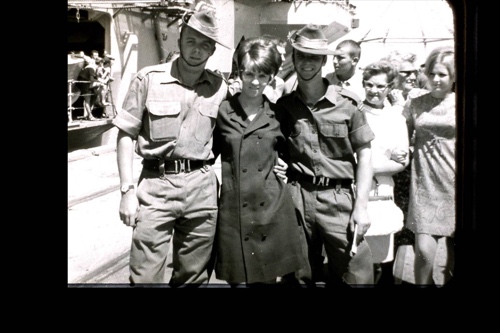
Pte Cooper and Pte Thomas
of A Company were also killed in the same action . The barrage was immediately followed by ground assault.
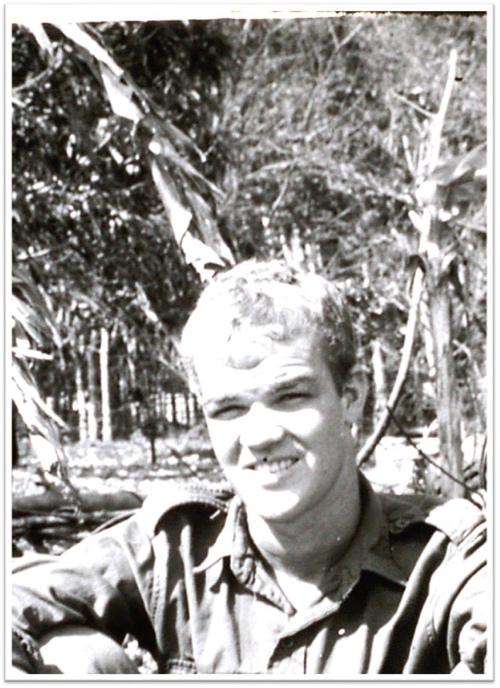
Australian War Memorial
Last Post Memorial
delivered 26 May 2013
Today is the 45th anniversary of the First Attack on the Battalion defensive position Balmoral, South Vietnam. We remember and pay tribute to Private Alan John Cooper, of the 3rd Royal Australian Regiment, who died 45 years ago today while fighting in this attack.
3RAR arrived in Vietnam in 1967. As part of the 1st Australian Task Force they were stationed at Nui Dat in the Phuoc Tuy province. In late April 1968 they took part in Operation Toan Thang, which aimed to block Communist forces withdrawing back to the north following the Tet Offensive. 3RAR was stationed on the Bien Hoa/Bien Nuong border.
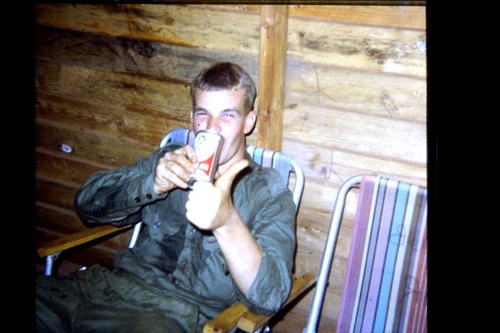
3RAR occupied Fire Support Base Coogee before moving five kilometers north on the 24th of May to establish position Balmoral. The men immediately began work on their defensive positions and wiring around the perimeter, while four Centurion tanks arrived from 2 Troop, C Squadron, to add fire support.
At 3.45 am on the 26th of May, 3RAR came under an intense barrage of mortar, rocket, machine gun, and small arms fire. It was during this bombardment that Private Cooper was killed by a mortar round which landed in his position.
As soon as the barrage lifted, a concentrated infantry attack was launched against D Company's position. At the same time, A Company's position was breached by North Vietnamese soldiers using improvised Bangalore torpedoes, but as this breach was not exploited it was thought this attack was a feint.
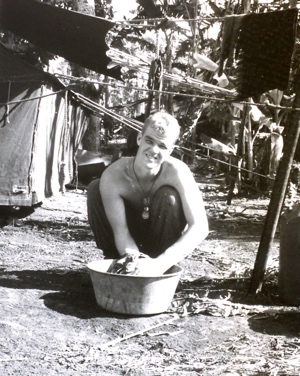
D Company, with the support of the centurion tanks and artillery fire from the nearby FSB Coral, were able to drive the North Vietnamese attack off with heavy losses. In the attack by the North Vietnamese 3RAR suffered three of its number killed and 14 wounded.
Two days later, Balmoral once again came under attack with a preliminary mortar and rocket bombardment before a ground assault. This attack was also repulsed. On the 5th of June the battalion withdrew from Balmoral back to Nui Dat.
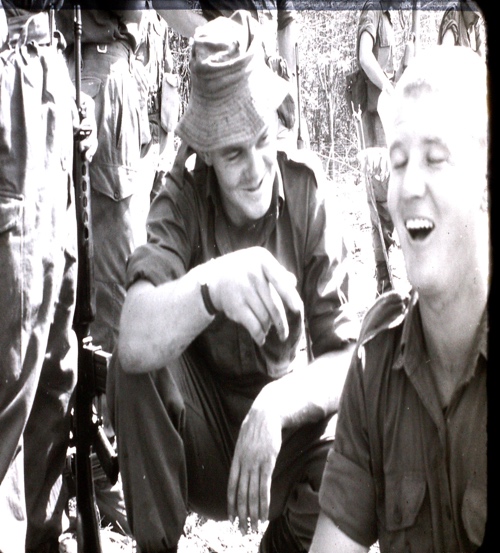
Download Here...
A speech by Gary Cooper, brother of Alan John Cooper Killed in Action
on the 26th May, 1968 and
delivered at the Commemoration of the 50th Anniversary of the Battles of Coral and Balmoral at the National Vietnam Veterans Memorial Canberra ACT in 2018.
also
Alan John Cooper
Australian War Memorial Last Post Ceremony
11th January 2018
Return to 3rd Battalion Roll of Honour Menu 1968 |
Battalion Defensive Position Balmoral
|
Perimeter sweep of Balmoral between enemy attacks. |
 |
Pte. Barry Norton Davidson
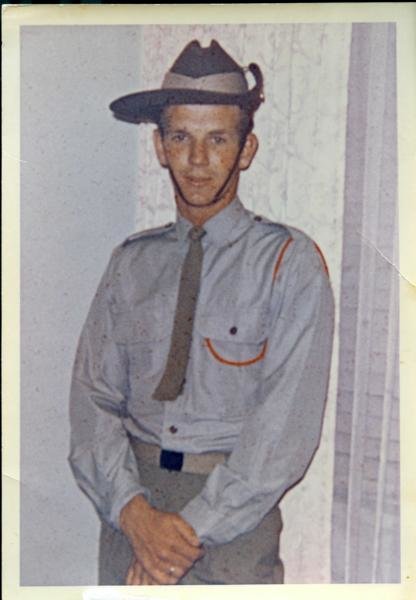
2788283 DAVIDSON Barry Norton, 22, of Sydney, NSW, was a plasterer when he was called up in October 1967. In July, 1968, in Vietnam, he volunteered to be a stretcher bearer and later was posted to B Company 3RAR as a rifleman.

He died of wounds received during a D Company contact in Long Khanh Province on 30th September, 1968. Interred in the Northern Suburbs Crematorium, Chatswood, Sydney, New South Wales, Australia
Return to 3rd Battalion Roll of Honour Menu 1968
|
Pte John Walker Desnoy

3791033 DESNOY John Walter, 22, of Melbourne, Victoria, was a guillotine operator in the printing industry when he was called up in April 1967. The private with 3RAR was killed in action in Bien Hoa Province on May 26, 1968.
Battalion defensive position Balmoral was assaulted by a North Vietnamese battalion force initiated by an intense barrage of small arms, machine gun, mortar and RPG rocket fire. Pte Brown (10 Platoon D Company and Pte Desnoy (12 Platoon D Company) died as a result of this barrage.
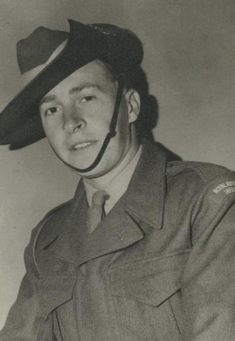
Pte Cooper and Pte Thomas
of A Company were also killed in the same action . The barrage was immediately followed by ground assault.
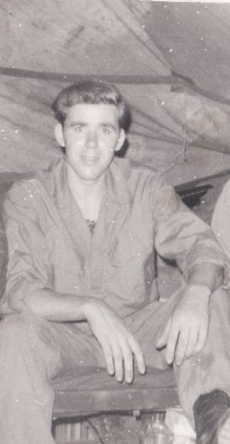 Return to 3rd Battalion Roll of Honour Menu 1968
Return to 3rd Battalion Roll of Honour Menu 1968
|
Pte John Alexander. Doherty

3789770 DOHERTY John Alexander, 23, of Bendigo, Victoria, was a boilermaker when called up in September, 1966. The private with 3RAR was dead on arrival at the 93 Us Evacuation Hospital after receiving head wounds during a mortar attack in Bien Hoa Province on 18 February, 1968.
A company sized enemy force reacted violently to an ambush and quickly with heavy gun fire and RPG rocket fire.
Lcpl Van Rysewijk and Pte Thompson were killed by rocket fire during this action whilst engaging an enemy HMG position with M60 machine gun fire. Five other platoon members were wounded in this action.
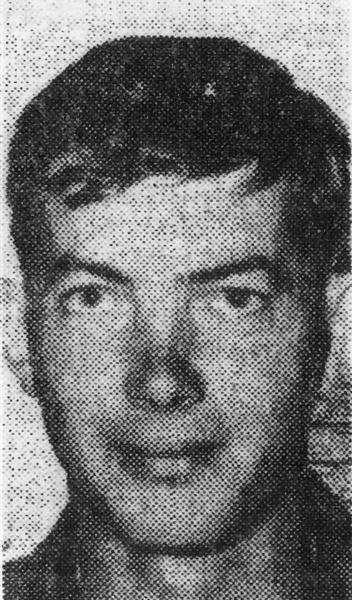
FSB Andersen was subjected to three attacks, the most serious being in the early hours of 18 February when an estimated enemy company attacked supported by mortars which were quickly silenced by the 3RAR Mortar Platoon. Seven Australians were killed including two from 3RAR (Pte's T.J. De Vries Van Leeuwen and J. A. Doherty) and 22 wounded in the attack. After a number of minor contacts 3RAR returned to Nui Dat on 1 March thus concluding the operation.
Bendigo Advertiser News
February 21 2016

WITH Australian flag firmly in hand, a large portrait and plenty of historic family photos, Bendigo’s Doherty family was proud to take part in a simultaneous state-wide Vietnam War service on Sunday
Along with the Trimble family, the groups gathered in Bendigo cemetery at midday to remember Vietnam veterans who lost their lives serving the country.
The two families gathered in front of the graves of their fallen ancestors John Alexander Doherty and Bevan Maxwell Trimble.
Darren Doherty, the son of John Doherty, was proud to stand with family members from as far abroad as New Zealand for Sunday’s service.
John Doherty – a prominent Kennington identity in the 1950s and 60s, as former owner of the Belmont Hotel and talented footballer – was killed just months after he arrived in Vietnam in 1968. He only saw his son Darren once, who was four months old at the time of his father’s death.
Mr Doherty said while Vietnam veterans were shunned by society upon their return, it had become a different story in modern times
“I think the amount of recognition they know receive has equalled what other veterans receive,” he said.
“As you can see, we have a very close family, and they all loved and adored him.”
The family’s experiences of war had been pained, with John conscripted only to be killed during a routine patrol soon after his arrival.
Families were charged $500 to bring the body of their loved one back to Australia, an idea which Mr Doherty considers an aberration.
“When I heard that was what families had to pay, I was insulted,” he said.
“He was conscripted for an unjustifiable attack on Vietnam, and then to ask the family to pay to bring his body back, it was unfair.”
Return to 3rd Battalion Roll of Honour Menu 1968 |
2Lt John Fraser

1731113 FRASER John, 23, of Surfers Paradise, Queensland, was called up in 1965 and completed two years’ National Service but re-enlisted when he learned his unit was going to Vietnam. The 2nd Lieutenant of 9 Platoon, C Company, 3RAR, died on Hill 323 in the Long Hai Hills, Phuoc Tuy, on March 24, 1968 when he stepped on an enemy mine.
1731113 2nd Lieutenant John Fraser, OC 9 Platoon C Company, and Pte Coles , 7 Platoon C Company, was killed by a mine whilst serving in Vietnam on the 24th of March 1968 in an act of supreme bravery.
John Fraser (1945-1968), national serviceman and army officer, was born on 12 January 1945 in Brisbane. He was employed as a cadet with the Australian Estates Co. Ltd when he was called up for national service on
29 September 1965.
Selected for officer-training, Fraser was sent to Scheyville, New South Wales, where he was described as 'steady', 'intelligent' and 'possessing leadership qualities'.
In April 1966 he was commissioned second lieutenant in the Royal Australian Infantry Corps and posted to the 2nd Battalion, Royal Australian Regiment. Next year he successfully applied for an extension of his national service to enable him to be considered for a one-year deployment to the Republic of Vietnam (South Vietnam). In October 1967 he was transferred to the 3rd Battalion, R.A.R. As commander of 'C' Company's No.9 Platoon, he sailed with the battalion to Vung Tau in December.
On 24 March 1968 No.9 platoon was engaged in clearing a safe lane along a gully towards a suspected tunnel entrance. During this slow and deliberate phase, Fraser accidentally triggered a captured M16 anti-personnel mine which had been placed by the Viet Cong to protect the tunnel's mouth. The M16 was of American manufacture and designed to jump about 3 ft. (91 cm) into the air before exploding. When he heard the mine arming, Fraser deliberately used his body in an effort to smother the effects of the blast and minimize injuries to those members of his platoon who were close by.
The explosion fatally wounded him and seriously injured three of his men. As he lay on the ground, he told his comrades not to approach because there were more mines around him.
Fraser died that day while being evacuated by helicopter; the other wounded soldiers recovered in hospital.
He was buried with Catholic rites and military honours in the Allambe Garden of Memories cemetery, Nerang, Queensland. A park in which he had played as a child, near his home at Surfers Paradise, was named in his memory.
Lest we forget.

Fraser, John (1945 - 1968)
Biography by Michael Boyle Australian Dictionary of Biography:
Reference:http://adb.anu.edu.au/biography/fraser-john-10243
Return to 3rd Battalion Roll of Honour Menu 1968
|
Cpl. Roger Leon Fisher

4718368 FISHER Roger Leon, 23, of Broken Hill, NSW, was a carpenter and joiner, when called up in July, 1966. The lance corporal rifleman of A Company 3RAR was killed by artillery in AO Hunter. Long Binh Province
on April 26, 1968.
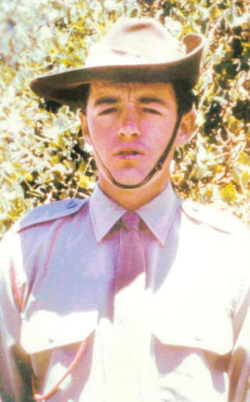
4718368 3RAR - Lance Corporal. Roger Leon. Fisher,23. Broken Hill NSW. Fisher was killed by a “drop “short” 105mm round fired by 106 RAA Battery just before sunset 26th April 1968. Mintaro Cemetery SA
Return to 3rd Battalion Roll of Honour Menu 1968 |
Pte Guy Richard Godden

6708763 GODDEN Guy Richard, originally from the UK, was a bank teller in Execter Tasmania at call up in February, 1967. The rifleman private with 3RAR was the first to be killed in action during the Tet offensive at Long Dien, Phuoc Tuy, on February 8, 1968 whilst attacking a well entrenched enemy position and pointing out a sniper position to his section commander.
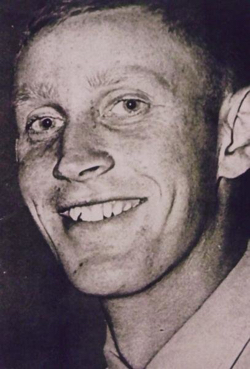
On the 7 February 1968 B Company 3RAR (Maj HW Irwin) was tasked to secure the approaches to Baria on the west of the Song Dinh and on the 8th February to support ARVN forces in clearing an enemy platoon from Long Dien. After securing the bridge over the Song Dinh, B Company moved by ARVN transport on 8th February to Long Dien and by late morning had deployed to the south west of the town.
Later that day, B Company was requested to search for a missing ARVN Battalion Commander and his US Army Adviser. At 6.30 pm 5 Platoon (2Lt LA Taylor) made heavy contact with a VC platoon located in and around brick houses. During a fierce exchange the platoon suffered two dead (the Platoon Commander 2Lt L A Fraser and the Platoon Signaler, Pte GR Godden) and suffered 5 wounded, one of whom later died (Pte GF Mathews). Some 15 of the enemy were killed and one captured before the remainder of B Company arrived to assist.

Guy Richard Godden Memorial Exeter, Tasmania. Australia
(Additional information would be welcomed on Guy. Email Tony)
Return to 3rd Battalion Roll of Honour Menu 1968
|
Pte Kenneth Raymond Houston

2787776 HOUSTON Kenneth Raymond, 23, of Katoomba NSW, was a policeman when he was called up in July, 1967. The private with 3RAR died in Phuoc Tuy of heat exhaustion, severe shock and suffocation on October 25, 1968.
He was a gentle giant, remembered by one nephew as so tall that when Uncle Ken picked him up “I could touch the ceiling”. Wayne Ranse, the nephew, also regards him as “a local hero”.
Ken Houston was born in Katoomba Hospital and attended Katoomba High School. He had three sisters, one of whom has died but the other two still “miss him greatly”, according to another nephew, Chris Ranse. “He had a big family and many, many friends who still remember him fondly.” he said.
Ken’s parents died within a year of each other in 1983-84. "They were heart-broken from the day he died,” said Wayne. “I remember as a kid [a seven-year-old] it was a very traumatic time for the family. And I recall when Ken’s funeral was on at St Hilda’s Church in Katoomba, all the shopkeepers closed out of respect for Ken.”
Some time after his death the family met Ken’s platoon leader, Lieutenant Peter Luffman, who had planted a lone pine in honour of the young soldier on his Goulburn property. Wayne Ranse described him as “a knockabout bloke. He was right into cars and didn't’t mind a beer.”
Ken Houston joined the police force after he left school and was serving as a constable when he was conscripted in July 1967. He was sent to Vietnam with the 3rd Battalion of the Royal Australian Regiment where he died in October 1968. Private Houston is buried in Katoomba cemetery, next to his parents.
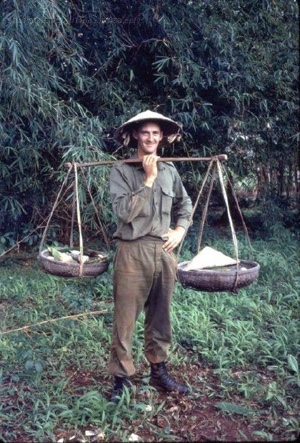 |
| VIETNAM 1968 |
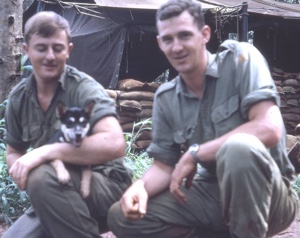 |
| Ken Houston, right, with a colleague on duty in Vietnam |
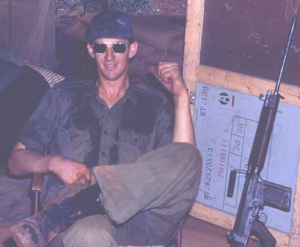 |
| Private Ken Houston. |
| Blue Mountains Gazette News Tribute June 23rd June 2017 |
|
Sgt. Peter Edward Lewis

43423 LEWIS Peter Edward "Joe" - 25 Years, 11 Platoon D Company 3 RAR - KIA 13 May 1968 by a VC sniper small arms fire at Fire Support Base Coral whilst siting Claymore mines around his platoon's ambush position.
A group of VC were spotted coming towards Lt. Mark John and Sgt Peter Lewis, who were placing claymore mines outside the perimeter. Sgt Lewis tried to get behind the Claymores but was hit by enemy fire. Cpl Dave Mercer was looking across the clearing, saw Sgt Lewis down and wounded and Lt Mark John on the ground. He was wondering what to do when he heard Sgt Lewis shout "Shoot over the top of me you mad bastard!. The enemy withdrew.
Sgt Peter Edward "Joe" Lewis
May He Rest In Peace
Sadly missed by 7025 Robert Franklin Seamark LEWIS (Enlisted in the R.A.A.F. on 6 NOV 1939 in Pearce, W.A.
Discharged 13 NOV 1945
Western Area Headquarter) and Mother Joan Darc Lewis.
Return to 3rd Battalion Roll of Honour Menu 1968 |
Pte Geofrey Francis Mathews

5714739 MATHEWS Geoffrey Francis - 3 RAR - 22 Years KIA 9 Feb. 1968.
Died of gunshot wounds at Long Dien.
On the 7 February. B Company 3RAR (Maj HW Irwin) was tasked to secure the approaches to Baria on the west of the Song Dinh and on 8 February to support ARVN forces in clearing an enemy platoon from Long Dien.
After securing the bridge over the Song Dinh, B Company moved by ARVN transport on 8 February to Long Dien and by late morning had deployed to the south west of the town. Later that day, B Company was requested to search for a missing ARVN Battalion Commander and his US Army Adviser.
At 6.30 pm 5 Platoon (2Lt LA Taylor) made heavy contact with a VC platoon located in and around brick houses. During a fierce exchange the platoon suffered two dead (the Platoon Commander and the Platoon Signaler, Pte GR Godden) and 5 wounded, one of whom later died (Pte GF Mathews). Some 15 of the enemy were killed and one captured before the remainder of B Company arrived to assist.
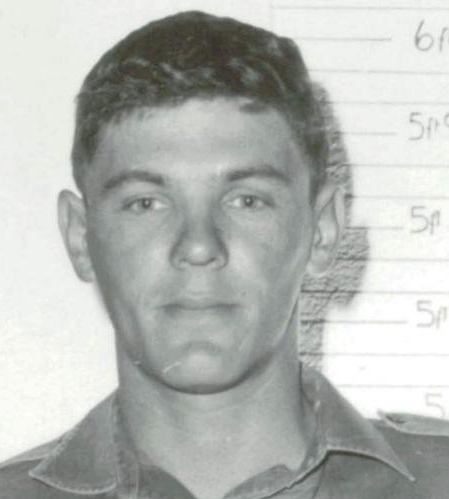
5714739 3RAR - Private. Geoffrey Francis Mathews 21 Perth WA. VC shot Mathews during an early evening patrol on 8th February 1968. He died of his wounds at dawn the following day in 24 US Evacuation. Hospital, Long Binh. Buried Karrakatta Cemetery WA
Return to 3rd Battalion Roll of Honour Menu 1968 |
Pte Garry Robert Polglase
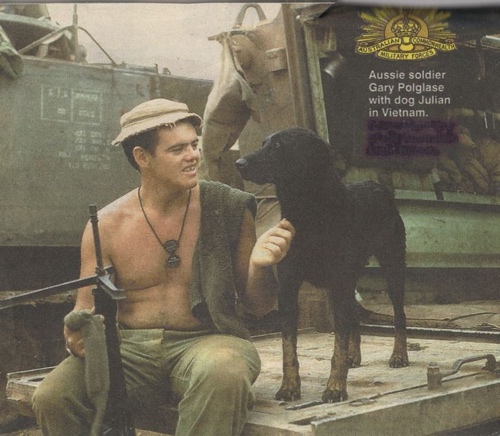
38763 Polglase Garry Robert, 20 Years. Originally from Northcote, Victoria.
Garry enlisted in the ARA on 1967 and was posted to the 3rd Battalion as a dog handler and tracker. He deployed with the Battalion to Vietnam at the end of 1967 and would see 108 days of service in country before his death on 13th of April 1968. Garry was a popular member of the platoon and respected by all who knew him.
Garry was a brave and honourable soldier in the tradition of the Anzacs who was tragically shot and killed by an accidental firearm discharge in the company lines in Nui Dat. Accidental deaths are common in war because of the everyday use and familiarity of firearms. Accidents can happen to professionals.
**************************************
My Life Story - Vietnam 1967-68 - The Long Hai Hills
By Lachlan Murdoch
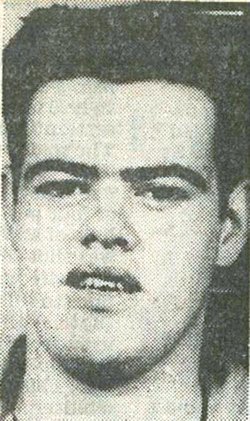
A day or two after we returned to our temporary base in the French ruins at the base of the Long Hais, my mate Garry “Polly” Polglase, a dog handler in the tracker team, came to the platoon commander and said that his dog, Julian, was unwell, and that he needed to go back to Nui Dat to give him the proper care. I tried to talk him out of it. Operation Pinnaroo was almost over. We had come through so much, and in just a few days we would all be going back together. But Polly was adamant, and no argument could change his mind.
That afternoon Polly and Julian boarded a resupply helicopter to fly back home to our base camp at Nui Dat. In my mind I can still vividly see the huge grin on his face as the chopper took off. He was clearly pleased that, at least for him, Operation Pinnaroo was over.
Early the following morning I received a message on the radio that was for the platoon commander’s ears only. I passed the handset to him, and when he handed it back to me a moment later, it was clear from the look on his face that he had been shocked by the message. He called the whole platoon together, and gave us the news: “Private Polglase is dead.”
The message was received with disbelief. Polly had escaped the extreme danger of the Long Hai Hills and returned to the relative safety of our base camp. How could he possibly be dead?
Our platoon commander went on to explain that, although he had no details, he had been informed that Polly and Willy Gutjahr had been the only people present when the incident occurred, and that Willie Gutjahr had apparently been in possession of an unauthorized pistol, purchased on the black market in Baria.
The mood turned from disbelief to anger, and several platoon members said “I’ll kill him!” But the platoon commander calmed things down and reminded us that we had to finish this operation, and when we returned to Nui Dat an inquiry would be held, and we would find out what had really happened.
I had no idea how to react to this news. Polly and I had become close friends at FSB Andersen, and the friendship had become even closer on this operation. I was stunned and speechless. Nothing I had experienced in my life up to this point had prepared me to deal with this. The other members of the platoon had known Polly longer that I had, and somehow they seemed able to get on with their work with a look of steely determination on their faces. I decided that I simply had to do the same.
That night was our last on Operation Pinnaroo, and we returned to Nui Dat the next day. I found that my tent had been surrounded with tape, and I was allowed to go in for only as long as it would take to pack my things and move out. At that moment it dawned on me that Polly must have been killed in my tent. That would make sense, given that I shared that tent with Willy Gutjahr, but somehow it hadn’t occurred to me before.
I sat down on my bed and started to pack my gear. There was a dark stain on the floor right next to my bed, and a smell of pine disinfectant. In the ammunition container that I used as a rubbish bin I found a Polaroid negative. That is the piece that is peeled off and discarded when a photograph is taken with a Polaroid camera. Although it was in negative, I could see the outline of a body, and the picture had clearly been taken right where I was sitting. A picture was starting to emerge. Not only was Polly killed in my tent, he was most likely sitting on my bed, chatting with Willy Gutjahr when he was shot and fell to the floor.
From that day to this, I have always tried to avoid pine disinfectant, because to me it is the smell of death. Even today, just around the corner in the quiet suburban street where I live, there is a pine tree which, at certain times of the year, gives off that same smell. Every time that smell hits my nostrils I am immediately taken back to that day and that tent at Nui Dat. That tree is between my home and the local shops and my son’s school, so I pass it every day. You would think by now that I would be ready for the smell, but somehow it always takes me by surprise and I relive the experience once again.
After I packed my gear, I went to the platoon sergeant and asked where I would be sleeping that night. He told me that the only bed that was available for me was Polly’s. So my friend had been killed in my tent, on my bed, and now I had to sleep in his bed. To make matters worse, Polly’s dog, Julian, was right outside the tent, just a few feet away, and he howled all night, pining for his friend and master. I spent the night listening to Julian’s howls, and reliving the sight of Polly grinning down at me as the helicopter took off, and my arguments to try to make him change his mind and stay with us until the end of the operation: “Just a couple more days mate, then we can all go back together.”
Aftermath
After Operation Pinnaroo I was transferred out of Anti-Tank Platoon into a new job in a different sub-unit of the battalion. That will be the subject of the next chapter.
Willy Gutjahr was transferred out of the battalion and I never saw him again. A few years ago I saw his name in a veterans’ magazine, on a list of veterans who had recently died.
One of the members of Anti-Tank Platoon, Wal Barnett, volunteered to take Polly’s place as Julian’s handler. This was an extraordinarily brave thing to do. He had no previous training as a dog handler, and he would have to start from scratch, teaching Julian how to respond to a new master. Wal did the job extremely well, and I have always had the utmost respect for him for taking it on.
In 1987 I spoke to a counselor at the Vietnam Veterans Counselling Service in Perth, Western Australia, about the events of Operation Pinnaroo, and particularly about the circumstances of Polly’s death. As a result of that counselling session I wrote a poem, “He Was A Mate.” That poem has developed a life of its own. It is now being studied by students all over the world, and is often used at Anzac Day, Vietnam Veterans Day, and other commemorative services. That poem will undoubtedly be the lasting legacy that I will leave behind when my life is over.
**************************************
This entry was written on by a Vietnam Veteran named Lachlan Murdoch, it appears on his web page.
Gary Polglase, aged 20 in Vietnam in 1968
he was a tracker dog handler
38763 Private Gary Robert Polglase, 3rd Battalion Royal Australian Regiment Age 20. A dog handler and tracker he was killed accidentally on 13th April 1968 at Nui Dat. Buried Springvale Cemetery Victoria.
Garry & his parents Horry (Dec 2006) & Agnes (Pat) Polglase (Dec 2009) were good friends of my Grandparents Dick & Norma Stewart as well as my father and mother. I spent time with Garry in Bacchus Marsh before he went off to Vietnam & was killed. I was only six years old.
The Long Hai Hills
(This entry was written on by a Vietnam Veteran named Lachlan Murdoch, it appears on his web page.)
The operation involved searching among mine fields and tunnels. The battalion suffered heavy casualties, as did the other units who supported us. As for myself, on this one operation, I lost a close friend, I took part in an ambush that killed an unarmed man, I personally sent in a false report claiming he had been armed, I witnessed at close quarters two separate fatal aeroplane crashes within a few days of each other, and I was bitten by a giant centipede, two ticks, two spiders, and countless ants and sand flies".
Garry Polglase was a tracker dog handler in 3rar anti-tank platoon. My family were good friends of the Polglase family, Pat and Horrie, we saw Garry off when he went to Vietnam. there was always a doubt about how he was killed. It is alleged he threw a gun on a card table and it went off, now we know that it is not true, the truth should come out for the sake of Gary and his family and all involved. the army should investigate this.
More from another web page on Vietnam-
The family of Garry Polglase, the handler of Julian, had a similar experience. PoIglase was accidentally killed in Vietnam in April 1968, and his mother applied to have the dog brought home soon after her son’s death. After questions were raised in Parliament, and the family had conducted a public campaign that raised enough money to pay the quarantine costs of all the tracker dogs, the Army confirmed its policy on the fate of the dogs and refused the request.
These refusals might have been easier to bear had the handlers been told one apparent reason for them. An Army veterinary report noted that large numbers of American tracker dogs in Vietnam had died from a tropical disease, thought (but not confirmed) to be transmitted by ticks. The disease, which very quickly caused massive hemorrhaging in all major organs, was hard to detect and could be carried by the dogs without symptoms for some time. The report strongly recommended that no tracker dogs be allowed back into Australia, “even under strict quarantine”, until the mode of transmission of the disease was discovered. By the end of 1972 the majority of Australian troops, including the dog handlers, were home from Vietnam. Most got on with their lives, more or less successfully, but their dogs were never far from their thoughts.
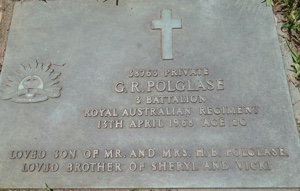
Return to 3rd Battalion Roll of Honour Menu 1968
|
Cpl. Anthony Vincent Quigley

4719160 QUIGLEY Anthony Vincent, 21, of Adelaide, SA, born 24 November 1946 was working as a driver when called up on April 20, 1967. The lance corporal in 3RAR died on November 5, 1968 during contact with the enemy on a night patrol.
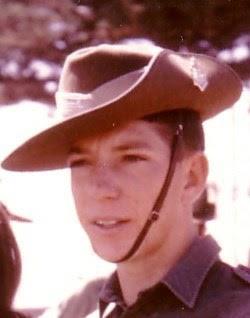
Anthony Vincent Quigley was born on the 24th November 1947 in Adelaide. He was one of a pair of twins to Vincent and Mary Quigley, but his twin died one day after they were born. The Quigleys were a devout Roman Catholic family. His father owned his own catering business, though Anthony, known to his friends as Tony, did not follow the family business. He went to school at Salesian College in Brooklyn Park. However he did not finish his education and went into the building business as a labourer and driver.
He was called up for National Service in 1967, aged 20. On enlistment, he was around 6 foot tall, muscly and had thick, wiry hair. He was sent to Puckapunyal in April 1967 for basic training. He was then sent to Singleton for infantry training in June 1967. He finished training in August 1967. He immediately joined 5 Platoon, B (Bravo) Company, 3RAR at Woodside Barracks in South Australia. He did not leave for Vietnam until 20th December 1967, so he went and saw his girl friend at the time before he left for Vietnam. Tragically, this was the last time they would see each other.
He was well respected by his comrades, rising to the rank of Corporal and became a section commander. He was a part of the Tet Offensive in February 1968, the unexpected battle for Baria on 1st and 2nd February 1968 and the costly and protracted battle for the Battalion defensive position Balmoral and FSB Coral in May and June 1968. This battle went on for 28 days and was one of the longest battles of the Vietnam War. He was admitted to the 1st Australian Field Hospital in Vung Tau in September 1968 for malaria, where many of his mates kept his spirits up, like he did for them on the battlefield. He returned to his battalion at the Task Force base at Nui Dat around the end of September 1968
The night before he was to return to Australia, Tony was commanding a patrol protecting the tactical area of responsibility (TAOR), as a favour for one of his mates so that his mate could see a friend off for rest leave in Vung Tau. Tony went to check the area when a Vietcong sniper heard him moving and shot at him. That shot was fatal. He died immediately on the night on 5th November 1968, aged just 21. One of his mates, when he returned home told Tony’s family that Tony was a great guy with good humour.
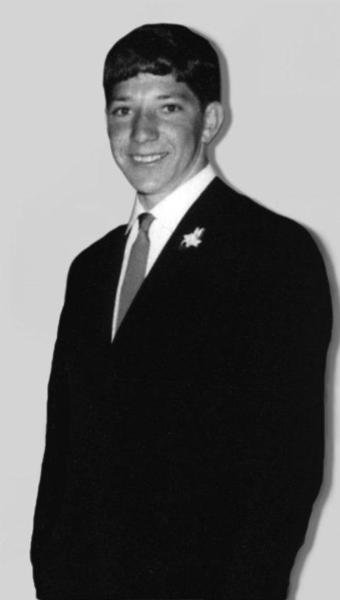
Although the youth of today may never know about the Vietnam War, many will know someone who was a part of it, so as the youth of today and the educators and historians of tomorrow, we must remember their sacrifice and duty to country. Tony has been a fascinating character to research. Although he did not form a family of his own, his siblings and parents would always know Tony as a hilarious guy who was very kind and I have spiritually adopted him into my own family.
Courtesy of Premier's Anzac Spirit School Prize
1 Oct 2018
Return to 3rd Battalion Roll of Honour Menu 1968 |
Pte John Robert Rapp
1201087 RAPP John Robert - 3 RAR - 23 Years KIA On 20 March 6 Platoon (2Lt D. O. Morgan) entered an enemy camp and received MG fire killing the Forward Scout Pte John Robert Rapp and wounding two others.
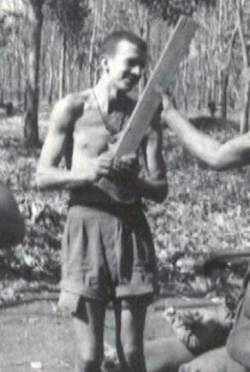
A troop of tanks deployed from FSB Herring to cover the platoon’s withdrawal; the following day, 5 Platoon (2Lt D.H. Ward) returned to the scene with tanks and discovered a substantial tunnel system.
Return to 3rd Battalion Roll of Honour Menu 1968 |
2Lt Leonard Alexander Taylor

3787987 TAYLOR Leonard Alexander, 22, a trainee sales representative from Sydney, NSW, was commissioned as a 2nd Lieutenant six months after call up on February 2, 1966. He extended his military service by 12 months and as a platoon commander with B Company, 3RAR, died of gunshot wounds in an enemy contact on February 8, 1968 in Long Dien, Phuoc Tuy.
On the 7 February. B Company 3RAR (Maj. HW Irwin) was tasked to secure the approaches to Baria on the west of the Song Dinh and on 8 February to support ARVN forces in clearing an enemy platoon from Long Dien.
After securing the bridge over the Song Dinh, B Company moved by ARVN transport on 8 February to Long Dien and by late morning had deployed to the south west of the town. Later that day, B Company was requested to search for a missing ARVN Battalion Commander and his US Army Adviser.
At 6.30 pm 5 Platoon (2Lt LA Taylor) made heavy contact with a VC platoon located in and around brick houses. During a fierce exchange the platoon suffered two dead (the Platoon Commander and the Platoon Signaler, Pte GR Godden) and 5 wounded, one of whom later died (Pte GF Mathews). Some 15 of the enemy were killed and one captured before the remainder of B Company arrived to assist.

OTU Scheyville
Death of a Scheyvillian – 2Lt Leonard Alexander Taylor, Class 1/66
3787987 Leonard Taylor was born on 16th August 1945 and was a trainee sales representative from Sydney. He was called up with the first intake in 1966 commencing Recruit Training on 2nd February. 16 days later he commenced his Officer Training at OTU. He graduated on 22nd July 1966 as Graduate 189 and was posted to 3 RAR. Len was due for discharge at the end of his 2 years on 1st February 1968, however, 3 RAR commenced its ‘Tour’ of Vietnam on 12th December and Len signed on for twelve months for the ‘Tour’. Len died from gunshot wounds on 8th February 1968 at Long Dien.
He is buried in the Box Hill Cemetery in Melbourne. 3 RAR’s ‘Tour’ ended on 5th December 1968.
The following information came via 3791271 Brian McKenzie, a Nasho who continued serving after his NS and retired as a Major in the Army Reserve’s 2 RVR, having served as a Company Commander at the Shepparton barracks. Brian’s ‘Tour’ with 3 RAR was from 20th December 1967 to 28th November 1968. For some time Brian was the President of the Vietnam Veterans Association of Australia.
CONTACT AFTER ACTION REPORT NO. 1 PART 1, PL SGT 5 PL, B COY, 5 RAR
Operation: LONG DIEN, Sub- sector 8 Feb 68 Strength of Pl in contact – 1 Offr, 24 ORs Date/Duration: 081830H – 1920H Feb 68 Location: YS 434587 Pl Task: To secure the LEFT flank at YS 433587 while 4 Pl searched in the area YS 431589 with two sections up. Approximately 40 metres to the front a figure dressed in greens was seen to run across the road from RIGHT to LEFT. All sections were informed and the platoon commander (Len Taylor) ran forward with his signaler (Nasho Geoff Mathews). Both forward sections were then engaged by heavy automatic fire from the front. This fire was immediately returned and voices were then heard calling ‘UC DA LOI, Don’t shoot, Don’t shoot, ARVN.’ The platoon stopped momentarily and the platoon commander stood up and was shot through the leg. At the same time 15 VC moved across the road from LEFT to RIGHT and deployed in front of the RIGHT forward section. This group of enemy was engaged. The rear section had deployed facing outwards on the LEFT flank and further VC were heard close to their location. The platoon was now under fire from front and two flanks. The RIGHT forward section commander advised the platoon commander that two of his section were wounded and was ordered to pull back. The LEFT forward section were then ordered to pull back and in doing so received three casualties.
At this time the platoon commander was killed and his signaller seriously shot through the head. Both the LEFT forward section and the rear section pulled back and deployed in rear of a large house. The RIGHT forward sections withdrew and met up with 6 platoon who had closed up in rear. The wounded were then treated and shortly afterwards the Company Commander and 4 Pl arrived.
Return to 3rd Battalion Roll of Honour Menu 1968 |
Pte William Michael Thomas

4718911 THOMAS William Michael, 21, of Adelaide, SA, posted to 3RAR, was killed in a pre-dawn enemy attack on Fire Support Base Coral, Bien Hoa, on May 26, 1968. This was one a series of failed actions by the Viet Cong and North Vietnamese forces between April and June to remove obstacles to attacks on Saigon.
At 3.30am on 26 May the enemy began a heavy mortar and rocket attack on Balmoral (1) causing casualties in 10 Platoon (2Lt RP O’Leary), 12 Platoon (2Lt NB Peatling), 2 Platoon (2Lt PH Fraser) and the Assault Pioneer Platoon (Lt. TJ Properjohn). At the same time a gap in the wire defences at A Company was made by Bangalore torpedoes.
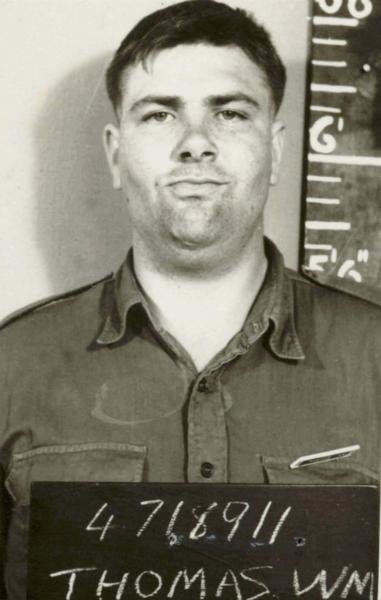
Recruitment Photo 1967
A short time later the main attack of an enemy battalion was made against D Company, especially 12 Platoon and into the teeth of the two Centurion Tanks positioned on D Company’s right flank (2). A combination of good Section weapon skills, artillery (from FSB Coral), mortar (3RAR) support and tank main and secondary armaments saw off the enemy attack; by first light it had left the field of battle leaving a number of dead. Three 3RAR soldiers were killed (Ptes L. N. Brown, A. J. Cooper and J. W. Desnoy) and fourteen wounded at Balmoral while another was killed (Pte W. M. Thomas) and one wounded at FSB Coral which had been subjected to a barrage of mortars and RPGs during the ground attack at Balmoral.
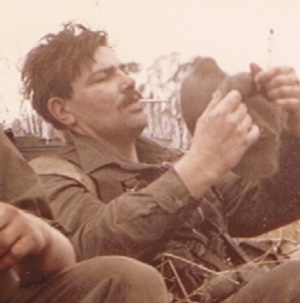
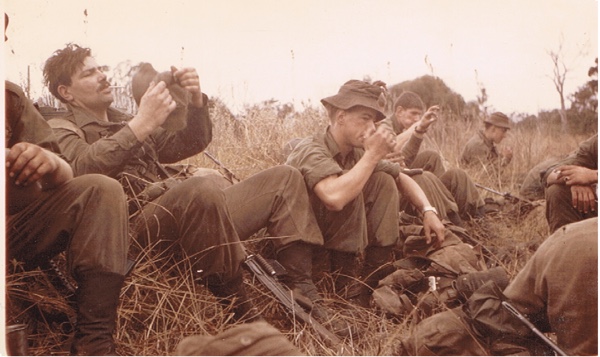
|
Pte Ian James Thomson

2786038 THOMSON Ian James, 22, of Albury, NSW, was an apprentice fitter and turner when called up on February 1, 1967. The rifleman private with 3RAR was killed by an enemy rocket propelled grenade's in a Phuoc Tuy rubber plantation on October 19, 1968.
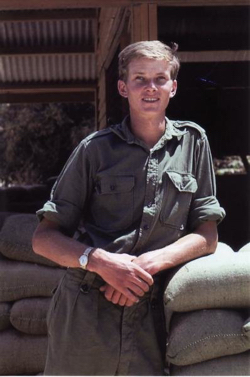
Ian James Thomson was born in Albury, New South Wales, on 19 December 1945 to Ted and Nancy Thomson. The eldest of five siblings, he and Wendy, Eddie, Harry and Nancy were raised on a farm at Thirlmere in Wollondilly Shire, just to the south-west of Campbelltown in New South Wales.
Ian loved a game of cricket with his mates, and he also loved motor cars and steam engines, having his own number of model steam engines.
Ian’s first car was a 2-tone blue FC Holden sedan and then after a few years saving sufficiently to purchase his first new car, a 1966 VW Beatle.
Ian often picked up hitch hikers and gave them a quick trip over Razorback Mountain north of Picton. Different days then and country towns. A contest of like-minded locals often tempted fate by doubling the recommended speed around the corners of Razorback Mountain in the day before the road was improved and redesigned. A larrikin at heart.
Ian attended nearby Tahmoor Primary School, and then Picton High, where his favourite subject was metalwork. After finishing school, he went into the fitting and machining trade, and continued training as a toolmaker. He was also an active member of the Citizen Military Forces but deferred his starting date for national service with the Australian Army, allowing him to complete his civilian trade. His skills meant that he was given the opportunity to transfer to the Engineer Corps –but he chose to remain with the mates he’d trained with in the infantry.
Nicknamed “Thommo” and “Stretch”, Thomson was a generous young man who had concern and empathy for all. But he was also a larrikin. He liked nothing better than to play a practical joke, and to be on the receiving end of one in return. He rolled Jaffa’s down the aisle at the movies, would be the first to jump off the highest rock at the waterhole, and first to ask a girl for a dance.
After basic, infantry and Jungle training, Thomson was sent to South Vietnam. He was first assigned was to the 7th Battalion, the Royal Australian Regiment, and then from mid-November to mid-December 1967, headquarters, 1st Australian Task Force. In April 1968. Ian Thomson was then assigned to the 3rd Battalion, the Royal Australian Regiment becoming a member of 2 Platoon, A Company. Maj Hori Howard company commander.
Heavy fighting took place during in the Tet Offensive at the beginning of 1968, followed by a mini-Tet in May and June. During the second half of the year, the Australians were involved in a series of gruelling, lengthy operations aimed at destroying enemy units in Phuoc Tuy Province and driving them from their remote bases and sanctuaries. This was designed to give the Australians better control over the province through their planned security and pacification program.
Operation Capital commenced on 12 October 1968 in the north-eastern Thua Tich district of the province. It was a gruelling operation, patrolling daily through difficult terrain, including dense jungle, and in ceaseless rain. It was a multi-battalion operation of increasing intensity, supported by US infantry and armour. Most clashes with the Viet Cong were intermittent: fleeting contacts and occasional intense actions, usually involving attacks on enemy bunkers. Enemy parties ranged from small groups to an estimated full company. But when they sensed an advantage, the Viet Cong would stay and fight.
After one brief contact on the morning of 19 October, Thomson’s 2 Platoon was attacked by a company-sized enemy force, using at least three machine-guns and rocket-propelled grenades. Thomson was on the heavy M-60 machine-gun with his mate, Lance Corporal Paul Richard Peter Van Rijsewijk. They quickly went to ground on the left flank and responded, pouring fire back at the Viet Cong, and keeping this larger enemy force from over-running the platoon.
But soon the enemy RPG rounds were directed into the trees above the pair, raining down shrapnel and splinters, seriously wounding both men. Despite this, Van Rijsewijk was able to indicate that both he and Thomson were still in the fight. With bravery and determination, they continued firing on the enemy. Platoon commander Second Lieutenant Peter Fraser called in artillery fire on the Viet Cong positions, and soon shells were exploding just metres in front of the Australians.
But then another volley of RPGs landed close by Thomson and Van Rijsewijk, and they were again hit. Two of their comrades, Privates Jessen and Bluzer, were able to crawl over to them, and between them managed to drag Ian Thomson and Paul Van Rijsewijk to a safer position. First aid was given, but L/Cpl Paul Van Rijsewijk died soon afterwards. With the help of two American helicopter gunships that put down suppressing fire, the platoon managed to withdraw to the relative safety of the company position. Ian Thomson, badly wounded but still alive and was carried out on a stretcher – but soon after arriving, he too died. After four hours the Viet Cong broke contact and withdrew, leaving behind seven dead. 6 other Australians were wounded in the action.
Private Kevin Booth, who took over as section commander, was awarded the Military Medal for his actions that day. He later said that the medal belongs to the whole section and paid particular tribute to his two machine-gunners, Ian Thomson and Paul Van Rijsewijk, who held their position under heavy fire despite being wounded. They had undoubtedly saved the platoon from being overrun by a superior force and had saved many of their mates’ lives.
Ian Thomson’s body was brought home and he was laid to rest in his hometown cemetery at Thirlmere. He was 22 years old when he was killed in action and with only 12 days remaining on his tour of duty.
This is but one of the many stories of service and sacrifice told here at the Australian War Memorial. We now remember Private Ian James Thomson, who gave his life for us, for our freedoms, and in the hope of a better world.
Eulogy story above researched by Tony Cox www.3rar.com.au in conversation with Harry Thomson (Ian's brother) and with Last Post Ceremony notes and family comments.
Return to 3rd Battalion Roll of Honour Menu 1968 |
Pte Thomas Johannes De Vries Van Leeuwen

4718756 DE VRIES VAN LEEUWEN Thomas Johannes, 22, born in Holland, was called up in February 1967. The private with 3RAR was killed in action in Bien Hoa Province on February 18, 1968.
Fire support Base Anderson was attacked following green flare sighting. A heavy barrage of mortars accompanied by RPG rocket fire
killed Pte Doherty (Mortar Platoon) and Pte De Vires Van Leeuwen A Company were killed in this bombardment.
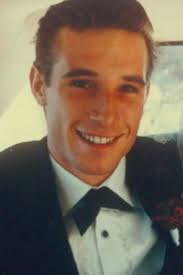
FSB Andersen was subjected to three attacks, the most serious being in the early hours of 18 February when an estimated enemy company attacked supported by mortars which were quickly silenced by the 3RAR Mortar Platoon. Seven Australians were killed including two from 3RAR (Ptes TJ De Vries Van Leeuwen and JA Doherty) and 22 wounded in the attack. After a number of minor contacts 3RAR returned to Nui Dat on 1 March thus concluding the operation.

Australian Wall of Faces
(No photo details available)
Return to 3rd Battalion Roll of Honour Menu 1968 |
Lcpl. Paul Richard P. Vanrijsewijk

5715180 VAN RIJSEWIJK Paul Richard, 21, from Surrey, UK, was a sales clerk when called up on April 19, 1967. He was posted to A Company, 3RAR as a rifleman lance corporal and was killed in action on October 19, 1968 in Phuoc Tuy during Operation Capital.
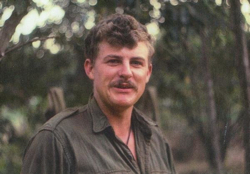
The following is an extract from "A Duty Done" by
Lieutenant Colonel (Retired) Fred Fairhead
On 19 October A Company 3RAR was in a firm base with 2 Platoon deployed to an ambush position some 500 metres west. At about 8 am the platoon engaged a single enemy soldier and as the ambush position was now compromised Platoon began to redeploy; it was then engaged (8) by an estimated enemy company using RPGs, HMGs and automatic weapons The Platoon suffered several casualties from RPG shrapnel including a Section Commander who was replaced by the Section 2IC (LCpl KJ Booth) who took control of the MG Group which was immediately engaged by RPGs, fatally wounding two soldiers (LCpl PRP Van Rijsewijk and Pte IJ Thomson). Artillery fire and a US Army Light Fire Team supported the Platoon in breaking contact with 1 Platoon (2Lt NM Bell) providing covering fire for 2 Platoon to withdraw to the Company position. Some twenty enemy were killed in the contact which lasted about four hours.
Return to 3rd Battalion Roll of Honour Menu 1968 |
Pte Jeffrey Thomas Worle

3790789 Jeffrey Thomas WORLE, 21 years of Melbourne, Victoria, a National Serviceman was a railway booking clerk when called up and posted to 3RAR. He was killed in a second attack on Battalion defensive position Balmoral, Bien Hoa, at 0230hrs on May 28, 1968. The North Vietnamese Regiment attacked with accompanying Mortar Fire. Pte. Jeffrey Worle of B Company was killed by this supporting fire.
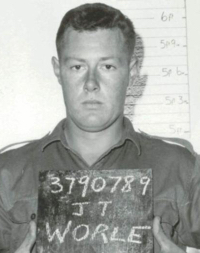 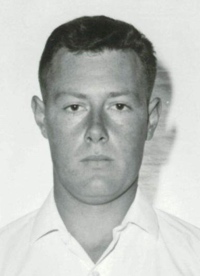
Extract from A Duty Done By Lieutenant Colonel (Retired) Fred Fairhead
At 2.30 am on 28 May, a regimental size force attacked Balmoral preceded by 60mm and 82mm mortar fire. The ground assault commenced with a small diversionary attack against A Company (Maj B. W. Howard) (3) which the Company stopped. A few minutes later the main assault came from the north east (4) with a secondary attack from the northwest (5). The whole of D Company (Maj P. R. Phillips) together with the Troop of Tanks (2Lt M. J. Butler) repelled the attack with Mortars, Artillery and Gunships adding to the rout of the enemy who left over forty dead and evidence of many more on the battlefield. 11 Platoon (Lt M. R. Johns) and especially the right forward section (Cpl D. J. Mancer) were heavily involved in the successful defence of the FSB. One A Company soldier was killed (Pte J.T. Worle) and six wounded during the attack.
In Memorial
On the 28th May 2021 we bow our heads and remember Australian Military Forces Soldier Private Jeffrey Thomas WORLE of The Australian Military Force.
Jeffrey Thomas WORLE was born in Melbourne, Victoria, Australia on the 20th July 1946 the son of Mr and Mrs of WORLE Melbourne, Victoria, Australia he attended the State School in Melbourne, Victoria, Australia and worked until he was Drafted for National service in Vietnam in 1967.
Jeffrey Thomas WORLE enlisted in 1966 In to the Australian Military Forces enlisting at the rank of Pte. with the service no. 3790789 and was posted to the Australian Military Force, and started his National service Training with the 2nd Royal Training Battalion and then he had Basic Training at Puckapunyal, Victoria and embarked with the unit from Australia bound for South Vietnam in 1966.
Pte. WORLE completed his national service Training with the 2nd Royal Training Battalion was posted to the 3rd Battalion, The Royal Australian Regiment starting his Service in 1967 and commenced operational service on the 20th Dec 1967 to the 26th May 1968 in South Vietnam.
Sadly, Pte. WORLE was Killed in Action in South Vietnam on the 26th May 1968 Age 21 while serving with the 3rd Battalion, The Royal Australian Regiment (3RAR) South Vietnam.
Pte. WORLE’s final resting place is at the Springvale Garden of Remembrance & Crematorium, Victoria
Grave Location: N/A
Pte. WORLE is also remembered on Panel Number 5 of the Roll of Honour, of the Australian War Memorial.
Pte. WORLE is also remembered on the Brighton War Memorial.
May you forever live on in our hearts and memories Jeffrey you will never be forgotten.
Lest We Forget
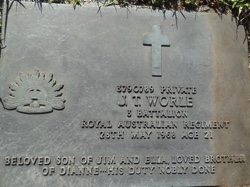
Father Henry James Worle Died (1985) and mother Ella Worle. Brother to Dianne.
BELOVED SON OF JIM & ELLA
BROTHER OF DIANNE...
HIS DUTY NOBLY DONE
|
 |
Return to 3rd Battalion Roll of Honour Menu 1968 |
